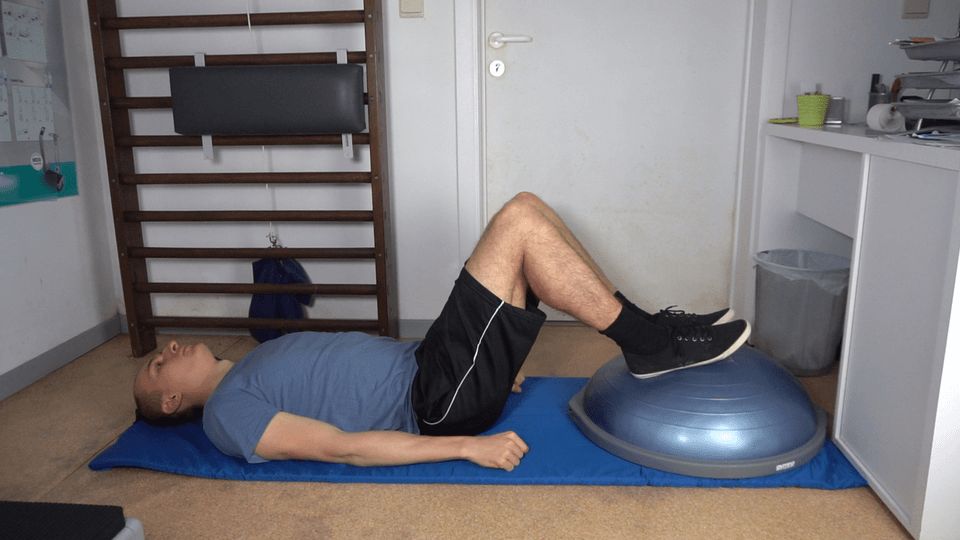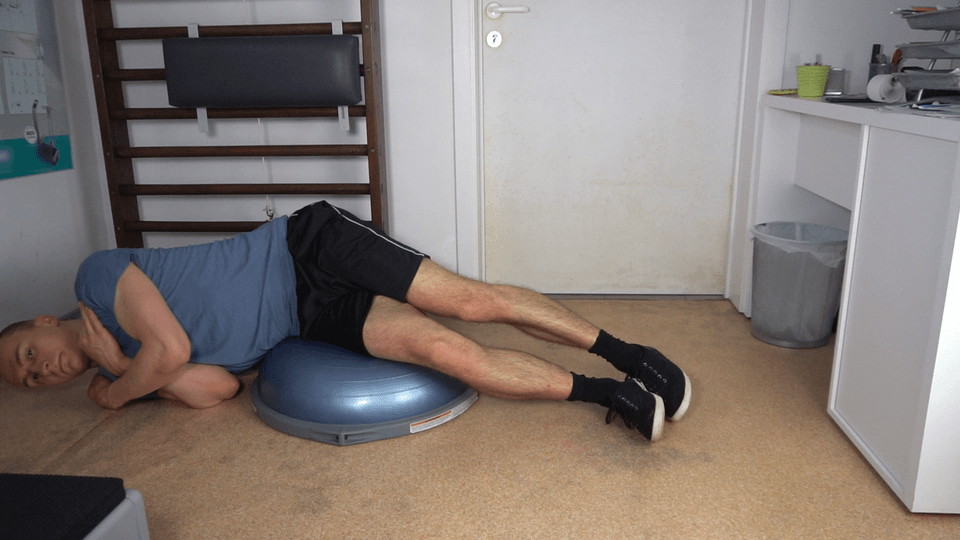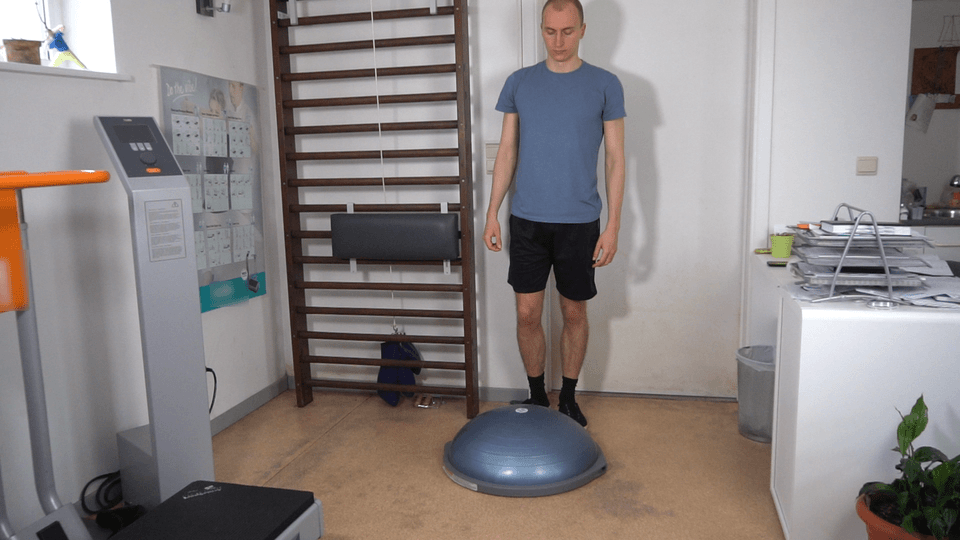Bosu Balls are a versatile piece of fitness equipment. You can also use it to do exercises that work your glutes, also known as butt muscles.
You can describe the Bosu Ball as the top of a stability ball attached to a flat surface. There are a lot of Bosu Ball exercises and some of these work your glute muscles a nice amount.
One thing to keep in mind is that your glute muscles are really strong. To be able to challenge them enough for muscle growth and strengthening you typically need to use a lot of extra resistance in the form of weights or resistance bands.
A downside of Bosu Balls for training your glute muscles is that they often make the exercise harder when it comes to balance. This and heavy weights are typically not a good combination for growing and strengthening your glute muscles. For optimal glute muscle growth and strengthening you typically want to do exercises with weights.
That being said, in a few cases, the Bosu Ball can benefit resistance training exercises by increasing the range of motion your muscles have to go through.
Additionally, you may find Bosu Ball glute exercises more fun than the ones with weights which can help with workout plan consistency.
1. Glute bridges
To do a Bosu Ball glute bridge take the following steps:
- Put the Bosu Ball with the flat part on the ground. If you have something like a yoga mat put it in front of the ball.
- Lie on your back on the floor or other soft surface right in front of the Bosu Ball. Place your feet slightly wider than shoulder-width on the ball. If you want to, hold any weights on your body at the hip level. If not put your arms at your sides for balance.
- Move up your hips in a controlled motion until your body is in a straight line from your knees to your shoulders. Make sure your arms are only used for balance, not for pushing yourself up.
- Slowly lower your body again.
Glute bridges are an exercise example where a good Bosu Ball can actually benefit your glute and hamstring muscle growth and strengthening by increasing the range of motion of the exercise.
If regular Bosu Ball glute bridges are too easy for you, you can also do the same exercise on one leg. This makes it so more weight rests on your leg. Additionally, you can hold some type of weight on your hips.

2. Lying side leg raises
In addition to your Bosu Ball, a yoga mat or other soft surfaces can make the exercise more comfortable. To do a Bosu Ball lying side leg raise take the following steps:
- Put the Bosu Ball with the flat side on the ground.
- Lie down sideways on the Bosu Ball. You want your hips to be on the top of the Bosu Ball and vertical like they would be when lying on the floor. Let your slightly less than stretched legs rest on the floor for now.
- Raise the upper leg upward as far as comfortable or until it is at about a 45-degree angle with the ground. Make sure the movement comes from your thighs. Keep your hips and the rest of your body still.
- Lower this leg back into the position of step 2 in a controlled motion.
- Repeat the same number of repetitions on your other side with the other leg.
By doing lying side leg raises on a Bosu Ball outer thigh muscles like your gluteus medius, gluteus minimus, and tensor fasciae latae have to go through a larger range of motion which is typically beneficial for muscle growth.
Most people think about the gluteus maximus when talking about butt muscles but you also have a few muscles on the side.
Initially, the bodyweight version of this exercise will likely be challenging enough. As you get stronger you can consider wearing ankle weights or using resistance bands.

3. Hip thrusts
To do a Bosu Ball hip thrust with a dumbbell take the following steps:
- Put the Bosu Ball with the flat part on the ground on a steady surface. Sit in front of it with your back towards the ball.
- Lie down on the Bosu Ball with your upper back on the highest position. Put your feet flat on the ground at a distance where your lower legs are vertical in the next step. Pick up the dumbbell, place it on your hips, and hold it there.
- Slowly move up your hips in a controlled motion until your body is in a straight line from your knees to your shoulders. Keep your neck and head in line with your upper body.
- Lower your hips again in a controlled motion until you are back in the position of step 2.
Make sure you don’t raise your hips too much. Going further than a straight line can be uncomfortable for your back. You can also use other weights for this Bosu Ball glute exercise.
Bosu Ball hip thrusts slightly increase the range of motion of your glutes muscles compared to floor bridges.

4. Bulgarian split squats
To do a Bosu Ball Bulgarian split squat take the following steps:
- Put the Bosu Ball with the flat part on the ground. Stand in front of the ball with your back towards it. Keep about half a leg distance between you and the Bosu Ball.
- Move one leg back and put the foot on the Bosu Ball. The top of your foot should lean on the dome of the ball.
- Slowly lower your hips by bending the knee of your stretched leg until your hip is at about the height of your knee of the previously stretched leg or as far as comfortable. Use your arms for balance if needed and keep your back straight throughout the movement.
- Push yourself up again into the position of step 2.
- Repeat the same number of repetitions on the leg of the other side to keep your muscle distribution balanced.
By elevating one foot on the Bosu Ball, you put more weight on your quadriceps, glutes, hamstrings, and calves. This can be beneficial for muscle growth.
Bosu Ball Bulgarian split squats are more of a compound Bosu Ball leg exercise that also focuses a lot on these other muscles. Especially your quadriceps (front thighs).
This can be both a benefit or downside depending on your training goals.

5. Lateral lunges
To do a Bosu Ball lateral lunge take the following steps:
- Put the Bosu Ball with the flat part on the ground. Stand up straight on the round part of the Ball.
- Take a big step sideways with one leg to the ground. At the end of this step, the knee of the leg that took the step is preferably at about a 90-degree angle or as low as comfortable. The upper leg of this side points forward in the same direction as your feet. The leg that stands on the Bosu Ball is slightly less than stretched. Bending over a bit is normal but try to keep a straight back especially if you add weights.
- Slowly move your body back into the position of step 1 by pushing with the folded leg.
- Repeat the same movement with your other foot taking the step.
Lateral lunges work your quadriceps, glutes, hamstrings, calves, inner thighs, and outer thighs. By using a Bosu Ball, more of your body weight rests on these muscles.
If needed you can make the exercise even more challenging by holding weights or wearing a weighted vest.

6. Donkey kicks
To do a Bosu Ball donkey kick take the following steps:
- Put the Bosu Ball with the flat side on the ground.
- Sit on the Bosu Ball on your hands and your knees with your arms slightly less than stretched. Look down to the ground throughout the exercise so your neck is in a straight line with your body.
- Move one foot backward and upward until the upper leg of this side is in 1 line with your body. Keep your knees at 90-degree angles throughout the movement. Keep the rest of your body in the same position.
- Lower this leg back into the position of step 1 in a controlled motion.
- Repeat with your other leg.
Donkey kicks are the first example of a Bosu Ball glute exercise where the regular floor version is generally more effective for training these muscles.
This is because the balancing makes it harder to use extra resistance which is generally needed to make the exercise challenging enough.

7. Lunges
To do a Bosu Ball lunge take the following steps:
- Put the Bosu Ball with the flat part on the ground on a steady surface. Stand in front of it.
- Put one foot on the middle of the rounded part of the Bosu Ball. Put your other foot at a distance where you can achieve the desired angles in the next step. Horizontally speaking you want your feet to be about shoulder width apart or slightly wider for balance.
- Slowly lower your hips by bending your knees. How far depends on different factors like knee health but at your lowest point you ideally want both your front knee and your front thigh to your body at about 90-degree angles. You can use your arms for balance if needed.
- Push yourself up again into starting position by stretching your legs. Your front leg will likely carry most of the weight.
- Repeat the same number of repetitions with your other leg forward.
Bosu Ball lunges are not as suboptimal compared to the floor version as donkey kicks. However, the extra balancing required can potentially get in the way of your glute training.
On the other hand, doing lunges on the Bosu Ball can slightly increase your range of motion in your quadriceps, glutes, hamstrings, and calves.

8. Fire hydrant
To do a Bosu Ball fire hydrant take the following steps:
- Put the Bosu Ball with the flat side on the ground.
- Sit on the Bosu Ball on your hands and your knees with your arms slightly less than stretched. Look down to the ground throughout the exercise so your neck is in a straight line with your body.
- Slowly move one leg sideways as close to a 90-degree angle in your hips as you comfortably can. Keep your knees at about 90-degree angles during the movement. Keep your hips and the rest of your body still to focus the most on your glutes.
- Lower this leg back into the position of step 1 in a controlled motion.
- Repeat with your other leg.
This exercise engages outer thigh muscles like your gluteus medius, gluteus minimus, and tensor fasciae latae. Adding a Bosu Ball to the fire hydrant typically makes it more challenging to work these muscles but does add some balance training.
Most people will need ankle weights, dumbbells, or resistance band loops to make fire hydrants challenging enough for muscle growth and strengthening.

9. Step-ups
To do a Bosu Ball step-up take the following steps:
- Put the Bosu Ball with the flat part on the ground. Stand upright in front of the ball facing toward it.
- Raise one foot and put it on the Bosu Ball. Make sure your sole is entirely on the surface but a bit on the side so you can stand in a balanced way in the next steps.
- Raise your body by exerting pressure with the leg of the foot that is on the Bosu Ball. Make sure the upper leg is doing most, preferably all, of the lifting.
- Put your second foot next to the other one.
- Step down with the first foot.
- Step down with the second foot.
- Do a repetition with the other foot first.
Bosu Ball step-ups work your quadriceps, glutes, hamstrings, and calves to some extent. One downside is that the range of motion is not that great due to the height of the Bosu Balls.
That being said, you can still use this exercise to grow and strengthen your glutes but some of the other Bosu Ball exercises are generally more effective for this.

